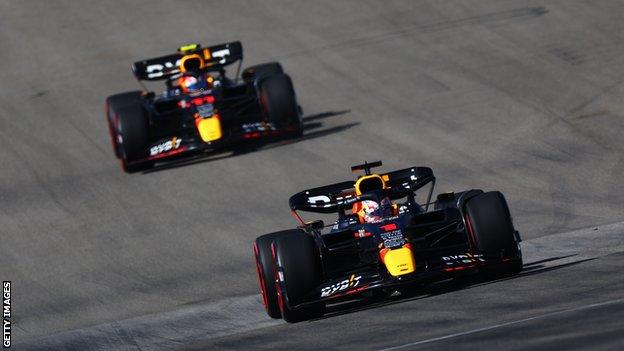Red Bull: F1 team receive $7m fine & 10% aero research reduction


Red Bull have been hit with a $7m (£6.07m) fine and a 10% reduction in permitted aerodynamic research for breaking Formula 1’s budget cap.
Governing body the FIA said that Red Bull had overspent by £1.86m in 2021.
Their financial punishment is not a reduction in their permitted spend next year, when the budget cap is $135m.
The 10% cut is in the time they can spend using their wind tunnel or computational fluid dynamics to design their car.
The punishment comes after Red Bull acknowledged they were at fault and entered into a so-called “accepted breach agreement” with the FIA.
The FIA had previously said only that Red Bull had committed a “minor” breach, which is anything up to 5% of the cap, or $7.25m in 2021, when Max Verstappen won his first title, with no further details.
A statement by the FIA detailing Red Bull’s errors said the team had “inaccurately excluded and/or adjusted costs amounting to a total of £5,607,000” in 2021.
The team’s overspend breach of relevant costs adjusted by the FIA was £1,864,000.
This amounts to an understatement of accounts of nearly 5% and an adjusted overspend of 1.6%.
A total of 13 points of non-compliance included an understatement related to their new power-unit business and fixed costs, and costs relevant to catering, social security, apprenticeships, inventory (unused parts) and non-F1 activities.
The fine has to be paid within the next 30 days.
Will the penalty have an effect?
Red Bull already had the lowest permitted aerodynamic research time for the first half of 2023 as a result of winning this year’s championship.
Last year, F1 introduced a sliding scale of aerodynamic restrictions in an attempt to close up the field, giving the lowest team in the championship the most research time and the highest the least.
Rival teams will have questions as to whether the punishment is appropriate, particularly over whether the fine will have any effect on a vastly wealthy global corporation, and also as to why the amounts published are different from those that were doing the rounds of the F1 paddock at last weekend’s US Grand Prix.
They will also likely point out that the areas of the overspend are irrelevant because they, too, could have chosen to spend more in such areas, but that would have meant spending less on engineering and car design.
